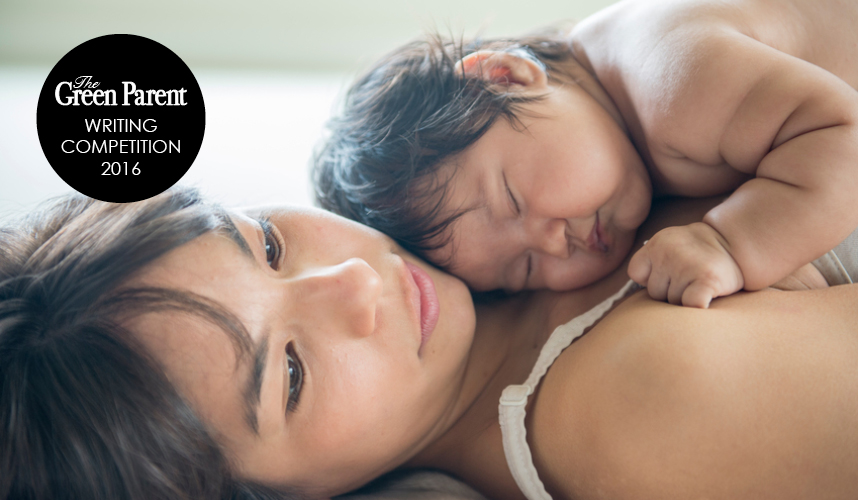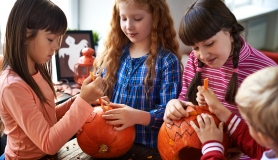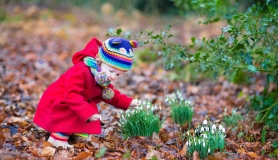Two months old and I am still getting to know my baby’s delicate features. I look into her deep blue eyes and feel a thrill of delight as her gaze meets mine. She wrinkles her button nose and emits a series of cute little grunts from her tiny pink lips.
Then…sppplat! She emits something from the other end too. Her face creases in relief and surprise and she grins the biggest smile I have seen all day. “Good one!” I say, beaming myself as I move her back from the toilet to the change mat.
I love elimination communication (EC) and have found it such a great way to learn and bond with my children. I discovered the practice, sometimes also called baby-led potty training or natural infant hygiene, when I was pregnant with my first child. To find out more, I turned to The Diaper-Free Baby by Christine Gross-Loh, an inspiring and practical guide which explains that babies are born with an awareness of bowel and bladder control and prefer not to soil themselves, which is why they so often catch parents off-guard during nappy changes! When caregivers practice EC, they can help children retain this awareness, preventing them from becoming dependant on nappies and then having to ‘unlearn’ this dependence when it’s time to toilet-train.
As I read that EC is common in many countries around the world, I remembered seeing a mother holding a baby above a drain in Vientiane, the capital of Laos, and young children elsewhere in Asia carrying their bare-bottomed siblings in brightly-coloured wraps. With little money or access to nappies, it made sense that there was another way to avoid frequent messes – the original way in fact, as our grandparents or great-grandparents would have done something similar too, when no-one wanted to be handwashing terry squares for three years or more.
Filled with enthusiasm, I envisaged trying the practice from birth, recognising the signs my baby needed to eliminate in the same way that I’d learn to tell when she was hungry or tired. Once she was born though, my world turned upside down and idealistic plans of pregnancy disappeared in the post-birth chaos. My husband and I occasionally experimented with cueing noises during nappy changes, but didn’t start to think seriously about EC until our daughter was around six months old and starting to try solid food.
Once we got started, we were quickly converted: the very first time we put our daughter on the potty, she entranced us by promptly filling it, and the next morning
brought further success. A week later, we began noticing subtle changes in her body language, such as the way she’d tense and twirl her wrists before a bowel movement. By seven months, we had waved goodbye to dirty nappies (bar a few rare accidents), at 10 months she could sign to tell us she needed to go and at 13 months we had a four-day holiday in which we only used two nappies. Things were a little different at nursery, so she was close to two before she switched to underwear full time, but we found the whole experience extremely rewarding and probably bored more than a few friends with our enthusiasm!
What I loved most about the process was the chance to communicate with my daughter way before she could talk, and revelling in abilities I thought only older children possessed. One day, on a long car journey, she signalled that a dirty nappy was imminent – and then managed to control her bowels for the four more junctions needed until we could pull off at a service station. On another occasion, with a dodgy tummy, she gave a sign from the pushchair which enabled me to ease her discomfort – and avoid a mess – before leaving the house of a friend (it was all the friend needed to be instantly convinced herself and she went on to practice EC with both of her own children).
When our second daughter came along, we started EC a little earlier – from about five weeks – but soon discovered that things would be quite different this time round. Although we mainly used cloth nappies as before, she was less bothered by being wet or dirty and less enthusiastic about signing as well. She would happily eliminate when given the opportunity after sleeps and at nappy changes though, so we encouraged her in that and enjoyed the face-to-face time those occasions brought, entertaining her with made-up songs and funny voices. Each new childhood development seemed slow to start, but fast to be perfected, and toileting independence was no different. One week we had almost given up on EC
as she grew increasingly stubborn and independent, refusing to join in; the next she decided just as defiantly that she was too big for nappies and it was time to move on.
Which brings us now to our very newest daughter, she of the button nose. Our EC journey begins afresh as we begin to decipher her unique squirms and wriggles, convey whispered toileting cues and gasp again in delight at each new success. Crouched down in front of her, supporting her soft thighs above the toilet, it feels amazing to connect in this way and a privilege to be able to try this natural form of parenting once more. If you’d like to try it too, here are my top five tips to make elimination communication a rewarding experience:
1) Enjoy the journey
I’ve been known to describe EC as the slow, scenic route to toileting independence. Although your child is likely to be out of nappies before their peers, this definitely shouldn’t be the main aim. As with anything baby-led, it’s about working and learning with your child; there may be weeks when it works and weeks when it doesn’t, but if you drop the perfectionism and go with the flow, you’ll be able to accept this as part of the journey.
2) Experiment to find what works for you
One of the best things about Gross-Loh’s book is the “three-track” concept, which demonstrates that absolutely anyone can explore and enjoy EC, from dedicated full-timers to more occasional users. We’ve been very much in the part-time camp, using nappies as back-up and encouraging childcare providers to try it too, but not worrying too much if they weren’t keen to get on board.
3) Develop your own methods of communication
You’ll find several recommended sounds and signs to use to communicate with your baby, but if none of these come naturally you may find it best to create some yourself. We found the traditional “psss” sound worked well for cueing our first daughter, but when she was old enough to learn a potty sign, all the ones in the books seemed too complicated, so we made up our own signals for needing to go and ‘finished’. Consistency is key, but as long as whatever you choose is simple enough for a baby to learn and clear enough that
you both recognise its meaning, the actual signs can be anything you like.
4) Adapt to the needs of each child
We found that, like Gross-Loh, we had very different experiences with each of our children. Our eldest daughter, for example, was happy to go anywhere and everywhere – she saw no difference in being held above a toilet, sink, bush or sand dune. Her younger sister, however, was more particular and preferred the comfort of home and her own familiar potty. She rarely eliminated when out and about until the week she decided she no longer needed nappies. We initially put a lot of effort into trying to encourage her outside the house,
but soon realised the best tactic was to respect her own individual preferences.
5) Relax and have fun!
Practicing EC has given our family so many funny and happy memories, from the time we had to stop by the side of the road to let an 11-month old poo in a bag to the silly songs and faces we’ve shared as we’ve held each of our daughters above the toilet in our bathroom. It’s not supposed to be another stick of ‘perfect parenthood’ to beat yourself with, but a refreshing alternative to the message conveyed by nappy manufacturers who have a vested interest in keeping our children out of pants for as long as possible. You’ll
know you’re doing it right when you see the smile on your child’s face as they sit on the toilet. And then turn to the bathroom mirror and see it reflected on
your own.
Anna Williams is a graphic designer and writer who loves cycling, the seasons, preloved treasures and cake. She lives with her husband and three daughters in Cambridge where they try to live a simple, green and happy life. Follow her journey to a more intentional way of living at www.thiswonderfulworld.co.uk







